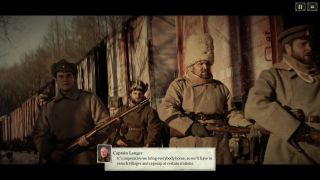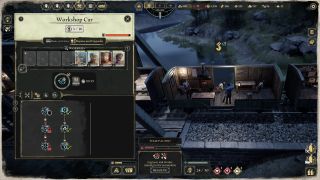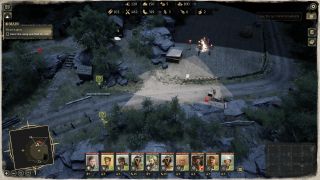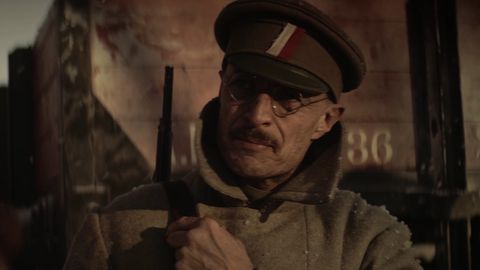Our Verdict
A rich, interesting, and honest experiment in history-as-game: If you're interested, play it.
PC Gamer's got your back
What is it? Survival management plus pausable RTS
Release date Out now
Expect to pay $40/£35
Developer Ashborne Games
Publisher THQ Nordic
Reviewed on Radeon RX 6800 XT, Ryzen 9 5900, 32GB RAM
Steam Deck Playable
Link Official site
Last Train Home is an engaging military management game and tactical RTS that puts you in charge of the Czechoslovak Legion as the Russian Civil War breaks out. Unable to return home by going west, you make a desperate plan: Capture an armored train and traverse Siberia. Your management of the journey is both on the train, assigning jobs and doling out supplies, and on the battlefield, controlling units of 10 soldiers in pausable, tactical RTS battles.
Last Train Home is not so much concerned with historicity as with giving you a glimpse into the desperate mood of a time and place. The Czech Legionaries don't want to fight on either side of the Russian Civil War. They really just want to go home, but nobody wants a large band of unaligned armed soldiers meandering about—least of all the Red revolutionaries, who quickly become your primary enemies.
It's historical fiction that reduces the events of tens of thousands of people over years down to dozens over months, but it's well-done fiction that conveys a time and place with fidelity in emotion and detail rather than precision of events. It's also richly presented, with music and art that far outstrips what anyone expects from a game at this level of development and budget.
Much of the historical fervor in Last Train Home is underwritten by the narrator: Captain František Langer, a historical figure whose presence feels authentically Czech. The real-life Langer was a doctor, poet, and playwright who fought with the Legion across Siberia. It gives the writers leeway to ensure his lines are not just fitting, but poetic—both his narration, in-scene lines, and FMV performance are written (in English) and delivered (in Czech) with soul befitting one of the great literary countries of the 20th century.
I'll illustrate by quoting the in-game Langer, saying that amid the violence of the civil war the sheer human misery simply never ended: "As did the fighting which went on and on without relent, a restless storm upon a human sea."

Bullets train
Managing to survive that storm is your real job. Your soldiers have to become multi-skilled people: riflemen and boiler-stokers and machine gunners and engineers and doctors and scouts and cooks all at once, jobs you have to blend for them in an almost subversively open-ended system of RPG-esque character classes. Managing personnel is a well-designed delight where you need to balance running lean with the idea that your best engineer could get blown up by a stray shell on any given mission. People wear out faster than equipment does.
It feels refreshing because games in this genre rarely give you a believable depiction of a fighting force—but Last Train Home does. These people are dirty and cold, learning by necessity. They're miles from the world-saving squad of hyper-specialized (and very clean) super soldiers that make up a Commandos crew or an XCOM campaign.

At the same time you've got to keep them fighting, fed, and warm by collecting supplies and managing your train, but every mile walked and battle fought eats into reserves of energy and health that'll have to be recovered lest their bodies and morale collapse. You send them out to defend from enemies, sure, but also on optional side missions—a Red militia is looting civilian farms, or a convoy is moving supplies you could probably use. Can we spare the men? Would it be better if we just sent them hunting, or looted that abandoned village instead? Rarely does military management present such compelling and unclear choices.
The weakest bit of Last Train Home is the RTS combat. The core design of it is perhaps too micromanagement-intensive, over-reliant on your ability to pause the game and redirect your troops mid-combat. That's forgivable, as it's fun to set up ambushes with overlapping fields of fire, pausing to optimally throw a grenade or snipe a machine gunner, but the real problem is that you don't really want to shoot. Since literally every bullet is desperately scrounged for, getting into a big firefight is the worst possible outcome.

You end up preferring stealth, but the controls just aren't there for a robust experience playing Last Train Home as a stealth strategy game. There's no dedicated button to differentiate between melee and ranged attacks, for example. In other years that might have been fine, but in a year that saw a stealth strategy game release by genre leader Mimimi—Shadow Gambit: The Cursed Crew—anything but a very competent stealth strategy experience just feels bad.
But don't come to Last Train Home for the RTS specifically: come to this one for the very human history and you won't be disappointed.
A rich, interesting, and honest experiment in history-as-game: If you're interested, play it.
Jon Bolding is a games writer and critic with an extensive background in strategy games. When he's not on his PC, he can be found playing every tabletop game under the sun.

